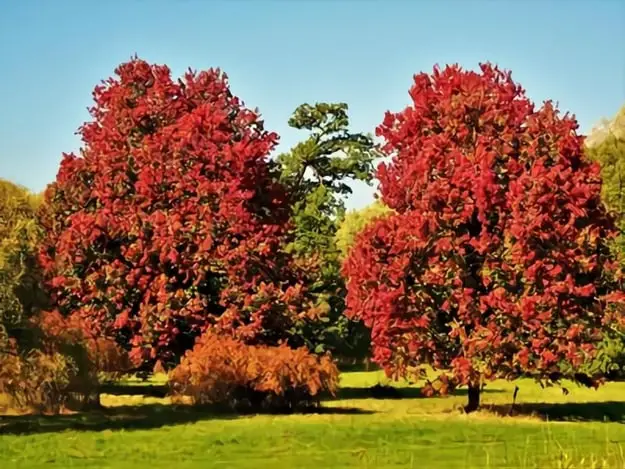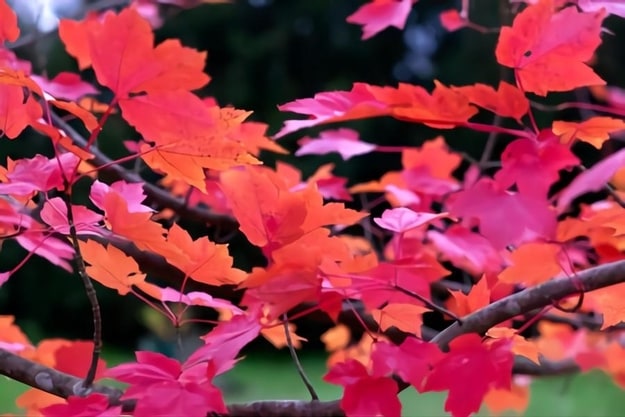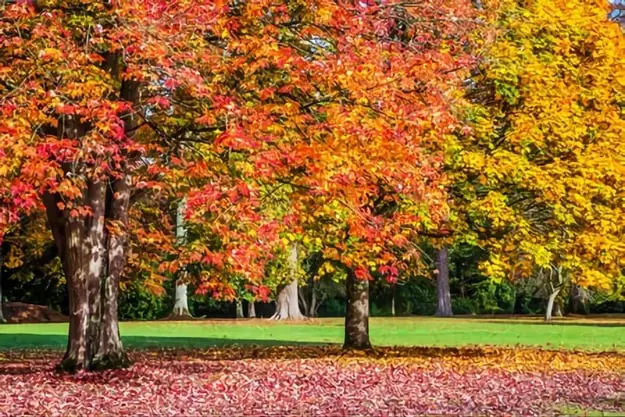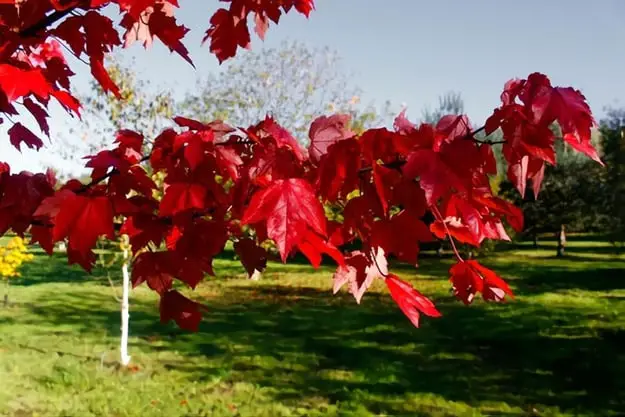The October Glory Maple (Acer Rubrum) is the perfect tree for your yard if you want to add color and beauty to your landscape. It’s a fast-growing tree that reaches heights of 40 to 50 feet, making it an excellent choice for large yards or small lots.
The October Glory Maple prefers north of zones 9 unless irrigated or near a water source, but will grow in southern Florida as well as northern Florida if provided with plenty of water.
This tree is preferred over other red maples, silver maple and box elder because of its fast growth rate and beautiful fall foliage. In December and January the leaves on this tree turn a bright red before falling off in February or March.
If you’re looking for a fast-growing maple with striking red foliage that will add some excitement to your yard this season, then look no further than the October Glory Maple!
In this post we are going to talk about the pros and cons of October Glory Maple. Let’s dive deep into it!
October Glory Maple Tree Pros
Beautiful fall color
It has beautiful fall color. This is one of the most popular maples for fall color. The leaves turn bright red in the fall, and this can be seen from a distance.
It grows very fast, and it can reach a height of 50 feet at maturity. It is easy to grow in most soils and climates, but it prefers moist soil that drains well.
It also likes full sun but can tolerate partial shade as well. This tree needs some pruning every year if you want to maintain its shape and size, but it is not necessary if you plant it in an area where it will get plenty of room to grow naturally without being crowded out by other trees or shrubs that might shade it out over time.
Good screen, shade tree
The October Glory Maple Tree is an attractive shade tree that lives up to its name. In the fall, its leaves turn a deep red and orange, which makes it stand out among the more common green trees of the season. It’s also known for its good screen and dense shade, making it a great choice for people who want to block out their neighbors’ view but still have plenty of sunlight in their own yard.
Easy to Transplant
October Glory Maple Trees have a root system that is both shallow and wide. This means that, if you want to transplant an October Glory Maple Tree, you can do so without much difficulty.
It’s important to note that you should not transplant an October Glory Maple Tree during the winter or summer months, as this can cause them to become stressed out.
October Glory Maple Tree Cons
October Glory Maple Trees need regular irrigation to support healthy growth.
While the October Glory Maple Tree is a popular choice for street tree plantings, it does have some cons.
The October Glory Maple Tree needs to be irrigated frequently in order to thrive in urban environments.
This watering requirement can be a drawback in areas that have water restrictions or are experiencing drought conditions. As a result this can be an expensive and time-consuming process.
Surface roots can make mowing difficult
The surface roots of the October Glory Maple Tree can make mowing difficult. Users may need to mow more often than usual, or use a different method of cutting grass.
The tree also has a tendency to drop twigs and leaves on the ground below, creating a mess that needs to be cleaned up regularly.
It does not tolerate drought well
The October Glory Maple Tree has a lot of great qualities, but perhaps one of its biggest drawbacks is that it does not tolerate drought well.
If you live in an area that experiences a lot of heat, you may have trouble keeping this tree alive. The roots can get damaged and the leaves will begin to turn brown/yellow.
If you’re going to be planting your tree in a location where it will be exposed to high temperatures for long periods of time, you might want to consider another species.
Pests Infestation
The October Glory Maple Tree is prone to pests infestation like aphids scales and borers. These pests cause leaf drop, discoloration of leaves, stunting and decline of trees. They also affect the overall health of trees by sucking out nutrients from their roots.
Although these pests can be controlled by following proper cultural practices, they may still cause severe damage if not taken care of on time.
Aphids can be found on many plants, including maples. They’re tiny insects that suck sap from leaves and stems of plants, causing them to become yellowed or distorted in shape. A good way to get rid of these pests is to use an insecticidal soap spray every few weeks during springtime until fall when they’re no longer active.
Scales are small insects that attach themselves to the outer bark of trees where they feed on sap from inside the tree’s trunk or branches. These little bugs can cause galls to form underneath them which will eventually kill off sections of your tree if left untreated over time! You can tell if there are any scales present by looking closely.
Borers are small insects that attack trees by boring holes into their trunks or branches causing them to die back or break off altogether. They can be controlled by pruning out infected areas before they spread any further throughout the tree’s canopy.
Diseases
One of the downside of October Glory Maple Tree is girdling roots. If you’re not familiar with this term, don’t worry we’ll explain it in more detail below. But first let’s talk about what girdling roots are and why they’re bad for your tree.
Girdling Roots: The Problem
A girdled root is when one or more roots from the trunk of a tree wrap around themselves and get stuck as they try to grow deeper into the soil. This stops nutrients from getting through and damages the tree’s ability to absorb water, which can eventually lead to death if left untreated.
Girdling roots occur when there isn’t enough space around the base of a tree for all its roots to grow freely without overlapping each other or getting tangled up together like braids in hair which makes sense since trees also have “hair”.
If there isn’t enough space between each individual root then they will eventually start growing together until they create one big root that wraps around itself like rope does when tightened.
The best way to prevent girdling roots is by making sure you water your October Glory Maple Tree well throughout the growing season so that it has plenty of moisture to keep its soil moist and loose enough to allow for proper root development. You should also ensure that you do not over-fertilize your tree, as this can cause excessive growth which could lead to more severe issues like girdling roots.
High temperatures can cause scorching
The October Glory Maple Tree is susceptible to scorching if temperatures are too high. Scorching happens when the leaves on the tree turn brown and die back.
This occurs when there is a lack of water or nutrients in the soil, which causes the leaves to dry out and die. If you live in an area with high temperatures, this is something you should be aware of in order to keep your tree healthy and beautiful.
Conclusion
The October Glory maples are great trees for those looking for a reliable, year-round tree. They have a reputation as one of the ‘best’ shade trees, which is an accomplishment in and of itself.
They are also quite ecologically friendly, relatively easy to maintain, and are known for their attractive fall colors. Overall, you won’t go wrong choosing this species as your next shade tree!
Also Read: Japanese Blueberry Tree Pros And Cons

